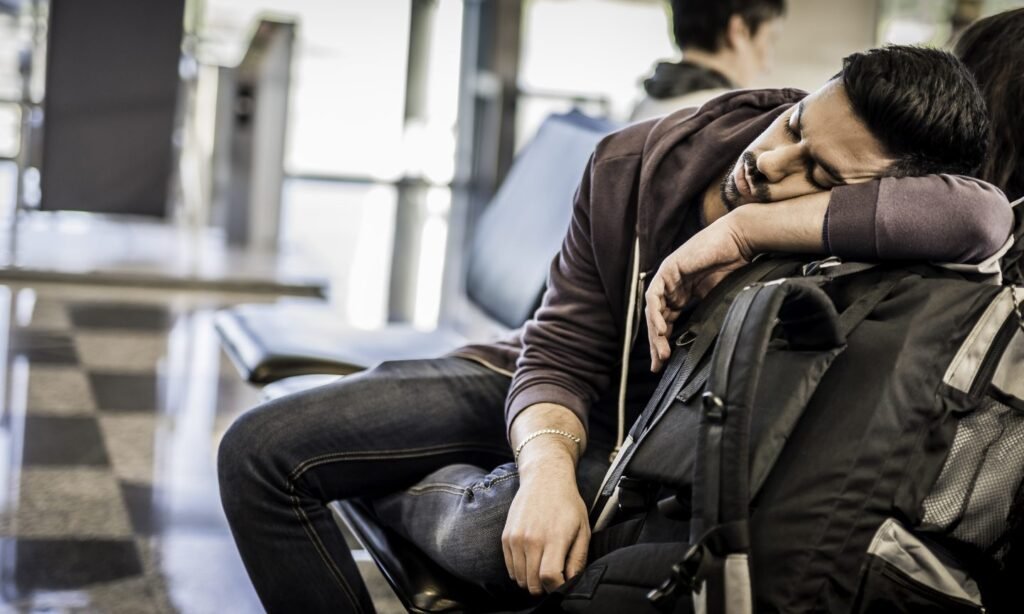Getting a good night’s sleep is crucial for health and well-being, especially when traveling long distances. However, situations like delayed flights, odd layover times, and expensive airport hotels can sometimes leave you with no choice but to sleep in an airport.
For international travelers who require a visa to enter certain countries, a long layover might mean spending the night at an airport. Before settling down with a pillow in a corner, it’s important to understand the conditions.
So, can you actually sleep in an airport? The answer is: it depends.
Every airport has its own rules regarding sleeping in the terminal. Some airports prohibit it entirely, while others allow it in designated areas. Some airports shut down for the night, while others remain open.
Sleeping in airports is more common at busy international airports that operate flights around the clock. For instance, airports like Dubai International Airport, Abu Dhabi International Airport, and Doha International Airport have flights departing at all hours. Across the globe, flight delays and cancellations can force travelers to spend the night in the airport.
Here are some essential tips for catching some shut-eye at an airport.
Where in an airport can you typically sleep?
Many airports offer various facilities to support travelers who need to sleep.
-
In-terminal airport hotels.Airport hotels in Doha, Qatar, and Istanbul allow travelers to stay within the secure area without going through immigration. Alternatively, there are airport hotels nearby, but they require leaving the secure area and sometimes passing through immigration.
-
Minute Suites.Minute Suites offer access to rooms with a bed and TV, pricing based on the length of stay. Travelers with Priority Pass can use these rooms for one hour free of charge and pay for additional hours. This is a great alternative to a lounge, especially if you need a quick nap. Note that these suites are only available in the U.S.
-
Recliners.Some airports provide reclining chairs for travelers to rest. These are available at SkyTeam hubs in Amsterdam and Paris, as well as terminals in Istanbul and Dubai. Singapore offers free-to-use snooze zones in each terminal.
-
Nap pods.Sleeping pods that resemble massage chairs with a cover are becoming more common in terminals. They require less space, making them easier for airports to install. You pay at the pod and close the cover for a nap, paying by the hour or minute. Airports with pods include Helsinki Airport in Finland, Doha, and Munich International Airport in Germany.
-
Onsite capsule hotels.Another option is the airport capsule hotel concept, where customers pay for a set number of hours to sleep in bunk bed-style beds. Luggage is stored separately, and a screen is drawn for privacy. Airports in Taipei, Taiwan, and Mexico City offer these, among others.
Tips for sleeping overnight
If you plan to sleep overnight at an airport, consider the following advice before putting on an eye mask.
You might get asked to leave
If there are no comfortable private facilities available, some travelers resort to sleeping on the floor or benches, using their luggage as a footrest, or napping in an upright chair. Not all airports allow individuals to stay after the last flight departs, and security personnel may request that you leave. However, having a valid boarding pass can increase your chances of being permitted to stay.
Another factor to consider is that airports are not quiet environments. There are cleaning crews, frequent overhead announcements (some of which can be repetitive and annoying), and constant lighting. If the airport is busy and passengers are struggling to find seats, it is considered poor etiquette to occupy multiple seats for a spontaneous nap while leaving others standing.
It can be noisy
Another consideration is that airports are not quiet places. There are cleaning crews, overhead announcements (some of which can become quite repetitive and annoying), and constant light. If the airport is busy and passengers are scrambling to find a seat, it is bad form to take up multiple seats for an impromptu nap and leave other people standing.
If you plan to sleep in an airport overnight, bring essential items like a blanket, eye shades, earplugs, and a pillow (or use your clothes to create one).
Your belongings may be at risk
Sleeping in airports comes with its own risks. If you are sleeping soundly and unaccompanied, your luggage could be stolen. To prevent this, secure your bag by putting an arm or leg through a strap so that you’ll be alerted if someone tries to move it.
🤓Nerdy Tip
If you plan to sleep in an airport overnight, bring essentials such as a blanket, eye shades, ear plugs and a pillow (or use some of your clothes for a makeshift one).
Consult online resources
Understanding what to look for at different airports can be beneficial for maximizing rest. Websites like SleepingInAirports.net provide information on the best spots at airports worldwide to catch some sleep, whether free, paid, or hidden from crowds.
If you visit an airline lounge that remains open 24 hours, and your layover extends overnight, this is another option for getting some rest.
Some airlines offer long connections that require many hours at the hub airport. Having lounge access provides a quieter space for resting with fewer airport announcements. While it may not be as comfortable as a real bed, some 24-hour lounges allow overnight stays.
Other lounges with specific operating hours may not permit stays past a certain time, and some, like American Express Centurion Lounges, prohibit sleeping at any time.

